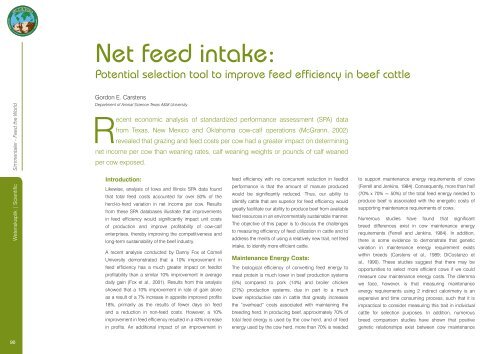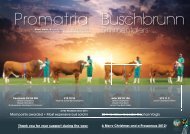Simmentaler Joernaal 2013.indb
Simmentaler Joernaal 2013.indb
Simmentaler Joernaal 2013.indb
Create successful ePaper yourself
Turn your PDF publications into a flip-book with our unique Google optimized e-Paper software.
<strong>Simmentaler</strong> - Feed the World<br />
Wetenskaplik | Scientific<br />
90<br />
Net feed intake:<br />
Potential selection tool to improve feed efficiency in beef cattle<br />
Gordon E. Carstens<br />
Department of Animal Science Texas A&M University<br />
Recent economic analysis of standardized performance assessment (SPA) data<br />
from Texas, New Mexico and Oklahoma cow-calf operations (McGrann, 2002)<br />
revealed that grazing and feed costs per cow had a greater impact on determining<br />
net income per cow than weaning rates, calf weaning weights or pounds of calf weaned<br />
per cow exposed.<br />
Introduction:<br />
Likewise, analysis of Iowa and Illinois SPA data found<br />
that total feed costs accounted for over 50% of the<br />
herd-to-herd variation in net income per cow. Results<br />
from these SPA databases illustrate that improvements<br />
in feed efficiency would significantly impact unit costs<br />
of production and improve profitability of cow-calf<br />
enterprises, thereby improving the competitiveness and<br />
long-term sustainability of the beef industry.<br />
A recent analysis conducted by Danny Fox at Cornell<br />
University demonstrated that a 10% improvement in<br />
feed efficiency has a much greater impact on feedlot<br />
profitability than a similar 10% improvement in average<br />
daily gain (Fox et al., 2001). Results from this analysis<br />
showed that a 10% improvement in rate of gain alone<br />
as a result of a 7% increase in appetite improved profits<br />
18%, primarily as the results of fewer days on feed<br />
and a reduction in non-feed costs. However, a 10%<br />
improvement in feed efficiency resulted in a 43% increase<br />
in profits. An additional impact of an improvement in<br />
feed efficiency with no concurrent reduction in feedlot<br />
performance is that the amount of manure produced<br />
would be significantly reduced. Thus, our ability to<br />
identify cattle that are superior for feed efficiency would<br />
greatly facilitate our ability to produce beef from available<br />
feed resources in an environmentally sustainable manner.<br />
The objective of this paper is to discuss the challenges<br />
to measuring efficiency of feed utilization in cattle and to<br />
address the merits of using a relatively new trait, net feed<br />
intake, to identify more efficient cattle.<br />
Maintenance Energy Costs:<br />
The biological efficiency of converting feed energy to<br />
meat protein is much lower in beef production systems<br />
(5%) compared to pork (14%) and broiler chicken<br />
(21%) production systems, due in part to a much<br />
lower reproductive rate in cattle that greatly increases<br />
the “overhead” costs associated with maintaining the<br />
breeding herd. In producing beef, approximately 70% of<br />
total feed energy is used by the cow herd, and of feed<br />
energy used by the cow herd, more than 70% is needed<br />
to support maintenance energy requirements of cows<br />
(Ferrell and Jenkins, 1984). Consequently, more than half<br />
(70% x 70% 50%) of the total feed energy needed to<br />
produce beef is associated with the energetic costs of<br />
supporting maintenance requirements of cows.<br />
Numerous studies have found that significant<br />
breed differences exist in cow maintenance energy<br />
requirements (Ferrell and Jenkins, 1984). In addition,<br />
there is some evidence to demonstrate that genetic<br />
variation in maintenance energy requirement exists<br />
within breeds (Carstens et al., 1989; DiCostanzo et<br />
al., 1990). These studies suggest that there may be<br />
opportunities to select more efficient cows if we could<br />
measure cow maintenance energy costs. The dilemma<br />
we face, however, is that measuring maintenance<br />
energy requirements using 2 indirect calorimetry is an<br />
expensive and time consuming process, such that it is<br />
impractical to consider measuring this trait in individual<br />
cattle for selection purposes. In addition, numerous<br />
breed comparison studies have shown that positive<br />
genetic relationships exist between cow maintenance



